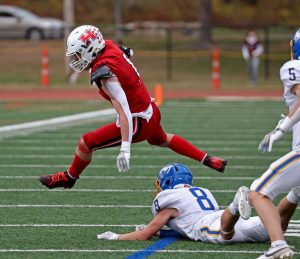
Colder water brings increased danger for boaters, paddlers as winter approaches
There are few things more scenic than an array of fall foliage reflecting off the smooth surface of a lake, viewed from a canoe quietly traversing the waters.
But even with a warmer-than-normal autumn, cool evenings and frost in most of the state mean that the water temperatures on Minnesota lakes and rivers are dropping steadily.
While safety is always a priority when venturing onto the water, no matter how warm it may be, the Minnesota Department of Natural Resources urges extreme caution for those who venture out hunting, fishing or paddling before freeze-up.
Even for those who swim well and are in good physical shape, a fall into cold water can shock the body, and with fewer people out on the water at this time of year, there are decreased chances of finding help nearby if a watercraft capsizes. Rapid cooling of arms and legs while immersed in cold water makes it harder to swim. The drowning of a Voyageurs National Park ranger last month underscores the danger.
The DNR’s advice is straightforward: Wear a personal flotation device.
An unexpected fall into cold water can cause an uncontrolled gasp reflex, heart attack or other physical distress. One way to ensure you survive the initial plunge is to wear a life jacket. The Minnesota Department of Natural Resources says there are more boating accidents in the warm summer months, but a higher percentage of fall and spring accidents are fatal as colder water brings increased danger. (Courtesy of the Canadian Safe Boating Council)
“This time of year, the water is particularly unforgiving,” Capt. Adam Block, DNR boating law administrator, said in a statement released by the agency. “Unfortunately, in the past few weeks, we have seen a number of people on the water either not wearing life jackets, or not even having them along. If there’s one thing you can do to ensure you make it home safely at the end of your trip, it’s wearing a life jacket.”
DNR numbers show more accidents are reported in the busy summer months when seemingly every Minnesotan finds a way to enjoy the water. However, more fatal accidents occur in the fall and spring in colder water.
In addition to life jackets, the DNR strongly encourages boaters to evenly distribute weight throughout the watercraft; pay attention to a boat’s posted weight limits; watch for inclement weather (especially high winds); always carry a cellphone; and notify a friend about where you are going and when you will be back.
The Minnesota DNR offers tips on how to survive a fall into frigid waters at mndnr.gov/safety/boatwater/cold-water.html. It includes a step-by-step guide on what to do in the first minute, the first 10 minutes, and the first hour following an accident.
Related Articles
For brilliant foliage, look no further than native trees
Duluth unveils reconfigured Brighton Beach, gateway to the North Shore
Skywatch: Halloween heavens
This Halloween, be safe when trick-or-treating by watching for cars
New Instagram filter helps tourists maintain a safe distance from wildlife


